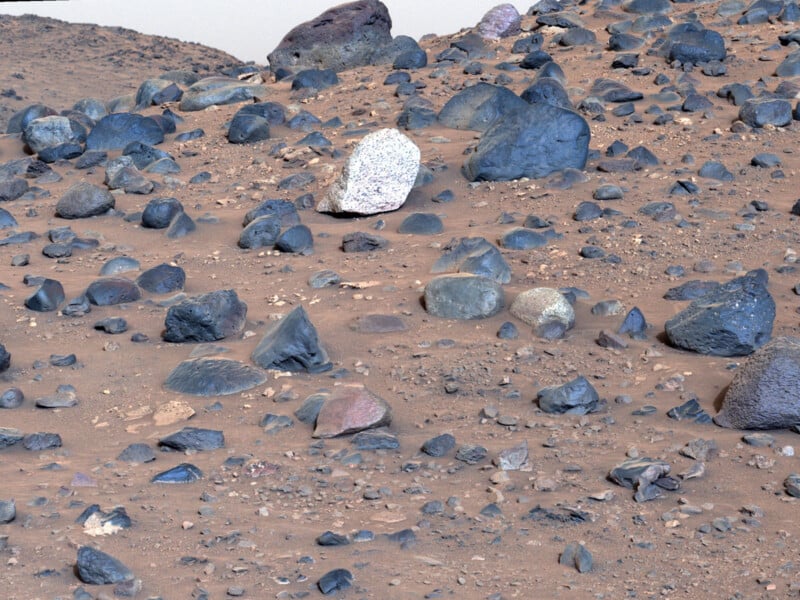![]()
NASA’s Perseverance rover captured the clearest view of Mars’ landscape yet, showing incredible blue rocks on the dusty surface that raise pivotal questions about the Red Planet’s complex history.
The new image from Mars shows rich, dark blue, jagged volcanic rocks scattered across an ancient Martian lakebed at Mount Washburn, named after a mountain in Yellowstone National Park. Alongside these beautiful blue rocks, Perseverance’s onboard cameras snapped a white rock, something never seen before on Mars.
“This was like the textbook definition of [chasing] the bright, shiny thing because it was so bright and white,” says NASA planetary geologist Dr. Katie Stack Morgan from NASA’s Jet Propulsion Laboratory (JPL).
“Every once in a while, you’ll just see some strange thing in the Martian landscape,” Dr. Morgan adds.
The Perseverance team captured the new images using the rover’s SuperCam, designed to examine rocks and soils on Mars using a camera, laser, and spectrometers, as well as the MastCam-Z.

The SuperCam system, which weighs 10.6 kilograms (23.4 pounds), is mounted on the “head” of the rover’s long-necked mast and can send 4.2 megabits of data back to Earth each day. As for the MastCam-Z, its primary job is capturing high-definition videos and panoramic color 3D images of the Martian surface. This camera weighs about four kilograms (8.8 pounds) and records roughly two-megapixel photos. It can send nearly 150 megabits of data to Earth per sol (Martian day).

The eye-catching white rock has been named ‘Atoko Point,’ and it is named after a large cliff in the Grand Canyon. The rock is about 35.6 centimeters (14 inches) tall, and thanks to SuperCam’s spectrometers, scientists have determined that the white rock is anorthosite, a type of rock that has never been observed on Mars before despite being long theorized.
This type of rock is exciting because, despite extensive research, it’s unclear how they form on Earth, let alone on Mars. This is the dominant rock type on the Moon, too, covering about 80% of the lunar surface. The volcanic Atoko Point rock may have formed deep below the Martian surface or may have been moved around by ancient Martian rivers that have long since dried up. At this point, it’s unknown.
What scientists do know, however, is that this rock is significant to understanding Mars and its history.







 Photographer Finds Locations Of 1960s Postcards To See How They Look Today, And The Difference Is Unbelievable
Photographer Finds Locations Of 1960s Postcards To See How They Look Today, And The Difference Is Unbelievable  Hij zet 3 IKEA kastjes tegen elkaar aan en maakt dit voor zijn vrouw…Wat een gaaf resultaat!!
Hij zet 3 IKEA kastjes tegen elkaar aan en maakt dit voor zijn vrouw…Wat een gaaf resultaat!!  Scientists Discover 512-Year-Old Shark, Which Would Be The Oldest Living Vertebrate On The Planet
Scientists Discover 512-Year-Old Shark, Which Would Be The Oldest Living Vertebrate On The Planet  Hus til salg er kun 22 kvadratmeter – men vent til du ser det indvendigt
Hus til salg er kun 22 kvadratmeter – men vent til du ser det indvendigt  Superknepet – så blir snuskiga ugnsformen som ny igen!
Superknepet – så blir snuskiga ugnsformen som ny igen!  Meteorite That Recently Fell in Somalia Turns Out to Contain Two Minerals Never Before Seen on Earth
Meteorite That Recently Fell in Somalia Turns Out to Contain Two Minerals Never Before Seen on Earth  Nearly Frozen Waves Captured On Camera By Nantucket Photographer
Nearly Frozen Waves Captured On Camera By Nantucket Photographer  It’s Official: Astronomers Have Discovered another Earth
It’s Official: Astronomers Have Discovered another Earth 